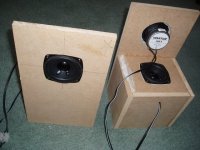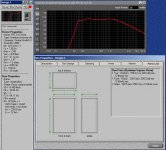Last edited by a moderator:
I'm wondering if a cardioid response is the goal...
Quote from the web page:
<This is a true dipole solution....
The hybrid dipole functions perfectly... >
A true dipole solution by the hybrid dipole, hmmm....
OK then.
At the first glance I thought there should be a chamfer cut on the rear. It's indeed there (from another picture in its web page), but the motor is just so big....
Quote from the web page:
<This is a true dipole solution....
The hybrid dipole functions perfectly... >
A true dipole solution by the hybrid dipole, hmmm....
OK then.
At the first glance I thought there should be a chamfer cut on the rear. It's indeed there (from another picture in its web page), but the motor is just so big....
Could you please elaborate?This guy seemed get a pretty good result (?) I'm not sure, can't read the articles. The diagrams look pretty good, though.gainphile said:I've done dipole+box hyrbid like this configuration before. They didn't sound right.
... .
404 Not Found
Last edited by a moderator:
I've made some, with smaller drivers, and no ports. Sound good to me. Will post pics when finished.
I might have read Gainphile's response wrong, but the idea of the rear driver is to cancel the backwave of the speaker, thus reducing bass cancellation to a minimal, then the front wave of the driver is free to send bass into the room, instead of around the baffle. Hence, the rear driver is in phase with the OB driver, but (personally) I don't think the ports are a good idea, because the rear driver should follow a similar excursion curve to the OB driver, so adding a port would create a dip in excursion at port tuning, thus reducing the cancelling effectiveness around that frequency.
Overall, the idea is that you get the nice midrange and treble of OB, and bass which wouldn't get cancelled.
Chris
I might have read Gainphile's response wrong, but the idea of the rear driver is to cancel the backwave of the speaker, thus reducing bass cancellation to a minimal, then the front wave of the driver is free to send bass into the room, instead of around the baffle. Hence, the rear driver is in phase with the OB driver, but (personally) I don't think the ports are a good idea, because the rear driver should follow a similar excursion curve to the OB driver, so adding a port would create a dip in excursion at port tuning, thus reducing the cancelling effectiveness around that frequency.
Overall, the idea is that you get the nice midrange and treble of OB, and bass which wouldn't get cancelled.
Chris
Hi, when I tried it basically it was dipole mid/high with ported sub. About 100Hz xo. If I remember the subjective presentation of the sound is "disjointed". Similiar symptom with box speakers, but different too. I've also heard similiar DIY product with the same presentation as well as electrostat + bandpass sub (Whise?).
I'm sure if measured from the front and back the polar response will be omni and becoming directional like normal box speakers. This may explain the characteristic of such combination.
Of course you will get the expected benefit such as "bass punches".
My subjective preference is when the response is kept relatively uniform. Sealed box is not bad at all if they are kept omni to high frequency, such is my cloned pluto. In fact the pluto's mid is very hard to beat. The "disturbance" is when the polar response changes, it seems.
One day I'd might try a "reverse" which is omni mid-high combined with dipole sub to "prove" the theory.
I'm sure if measured from the front and back the polar response will be omni and becoming directional like normal box speakers. This may explain the characteristic of such combination.
Of course you will get the expected benefit such as "bass punches".
My subjective preference is when the response is kept relatively uniform. Sealed box is not bad at all if they are kept omni to high frequency, such is my cloned pluto. In fact the pluto's mid is very hard to beat. The "disturbance" is when the polar response changes, it seems.
One day I'd might try a "reverse" which is omni mid-high combined with dipole sub to "prove" the theory.
My passive open baffle
The dimension are 102cm height x 40cm large x 30cm deep. Weight 18kg.
The drivers are :
Peerless SLS135 830669
Peerless SDS134 830656
Vifa DX25TG05-04
The frequency response -3dB 50Hz to 25kHz.
Point of crossover 500Hz and 2500Hz.
Sensitivity 82.5dB +-2.5dB.
Impedance 4ohms. Minimum 2.9@43Hz.
see here for a little more details.
Big passive OB project - diyAudio
The dimension are 102cm height x 40cm large x 30cm deep. Weight 18kg.
The drivers are :
Peerless SLS135 830669
Peerless SDS134 830656
Vifa DX25TG05-04
The frequency response -3dB 50Hz to 25kHz.
Point of crossover 500Hz and 2500Hz.
Sensitivity 82.5dB +-2.5dB.
Impedance 4ohms. Minimum 2.9@43Hz.
see here for a little more details.
Big passive OB project - diyAudio
Last edited by a moderator:
These are actually quite small (especially for OB), at 12" high and 7" across. 2nd order active eq (becomming passive so I can use only one amp), at 100-150Hz (Low pass) for the rear driver, full range for the OB driver.
It does bass fairly well - there's notes it can't hit - but most of is there. The midrange is good, lots of reflections in-room which makes stereo imaging wider (extends a good few feet past the speakers). Treble could be smoother, but this is a cheap 3" driver. I plan to get hold of some 5 or 6" full range drivers, and make a bigger version of this.
Doing a frequency sweep, 60Hz is audible but a few dBs down on 100Hz, which is pretty much flat with 1KHz reference.
These are unfinished, but I'm unsure on which colour to paint them. Traditional black? Some other less traditional colour, like bright green?
Chris
It does bass fairly well - there's notes it can't hit - but most of is there. The midrange is good, lots of reflections in-room which makes stereo imaging wider (extends a good few feet past the speakers). Treble could be smoother, but this is a cheap 3" driver. I plan to get hold of some 5 or 6" full range drivers, and make a bigger version of this.
Doing a frequency sweep, 60Hz is audible but a few dBs down on 100Hz, which is pretty much flat with 1KHz reference.
These are unfinished, but I'm unsure on which colour to paint them. Traditional black? Some other less traditional colour, like bright green?
Chris
Attachments
when palyng with a second driver is it needed to have a baffle so (relativetly to the small fr) wide? given quite no bafflestep from the floor or desk for the rear up facing driver shouldn't it work also on a very narrow baffle. was thinking at a pair of desktop speakers...
gainphile you did some experiment on your blog with desktop ob, very close to a backwall and sitting on a desk, can you comment your experience now that you have done the big thing?
gainphile you did some experiment on your blog with desktop ob, very close to a backwall and sitting on a desk, can you comment your experience now that you have done the big thing?
It's good, extension is fine, but the dip near the top doesn't improve the sound. Super tweeter would fix this nicely. Otherwise, treble is nice to listen to - not too harsh etc.
15KHz to 20KHz falls off, so, if you listen to anything really high up, you'd want to use a tweeter (perhaps ribbon if you were feeling adventurous) to cover it.
Surprisingly, the tibre of the sound is very realistic - cymbals sound metallic etc so I'd say a very good buy.
Dimensions for the wood you'll need to cut (this is per box, double for a pair) using 12mm MDF
1x 12"x7"
2x 5.5"x6"
2x 5"x6"
1x 6"x6"
Use batons when gluing (extra support while drying), and the drivers should be 2" from top, and sides.
XO is (for me) 2x 4.7mH inductors (because I can buy those) and a 80uF cap (same reason) giving a XO frequency of 150Hz (ish)
Feel free to copy this, or mess around with your own values.
Chris
15KHz to 20KHz falls off, so, if you listen to anything really high up, you'd want to use a tweeter (perhaps ribbon if you were feeling adventurous) to cover it.
Surprisingly, the tibre of the sound is very realistic - cymbals sound metallic etc so I'd say a very good buy.
Dimensions for the wood you'll need to cut (this is per box, double for a pair) using 12mm MDF
1x 12"x7"
2x 5.5"x6"
2x 5"x6"
1x 6"x6"
Use batons when gluing (extra support while drying), and the drivers should be 2" from top, and sides.
XO is (for me) 2x 4.7mH inductors (because I can buy those) and a 80uF cap (same reason) giving a XO frequency of 150Hz (ish)
Feel free to copy this, or mess around with your own values.
Chris
Time to include the great work of StigErik!
My open baffle dipole with Beyma TPL-150 - Page 20 - diyAudio
Those are 21" woofers btw.
My open baffle dipole with Beyma TPL-150 - Page 20 - diyAudio
An externally hosted image should be here but it was not working when we last tested it.
Those are 21" woofers btw.
Last edited by a moderator:
Another attempt to clone the CS2
MJAO G 098 - The Anagram - Crossover revision
MJAO G 098 - The Anagram - Crossover revision
An externally hosted image should be here but it was not working when we last tested it.
Last edited by a moderator:
those look pretty cool chris FRS8 is available for £10 in the uk and has very flat response from about 100Hz:
http://www.visaton.com/bilder/frequenz/gross/frs8_8_fs.gif
however realisticly with some active EQ I would only hope for response down to 80Hz (which is enough to get the first harmonic of a double bass's lowest note (47Hz) in and so would sound pretty respectable).
I will stick that driver in bassbox and see how low it can go
http://www.visaton.com/bilder/frequenz/gross/frs8_8_fs.gif
however realisticly with some active EQ I would only hope for response down to 80Hz (which is enough to get the first harmonic of a double bass's lowest note (47Hz) in and so would sound pretty respectable).
I will stick that driver in bassbox and see how low it can go
The FRS8 was used with a ported cabinet in Klang&Ton 3/2009. They achieved 100 Hz, which is pretty much the same you get in a closed box. The port helps a bit with the achievable SPL. But even with that the FRS8 is too small to produce significant SPL at low frequencies. Compression will start somewhere below 200 Hz to 300 Hz. A fine speaker, if you listen at adequate volumes. Not a fine speaker, if you ask too much of it.
The deepest note of a double bass is 32,7 Hz (,C). A 4-string electric bass guitar already goes down to 41,2 Hz (,E). http://www.psbspeakers.com/audio-topics/The-Frequencies-of-Music
The deepest note of a double bass is 32,7 Hz (,C). A 4-string electric bass guitar already goes down to 41,2 Hz (,E). http://www.psbspeakers.com/audio-topics/The-Frequencies-of-Music
- Home
- Loudspeakers
- Multi-Way
- Ultimate Open Baffle Gallery


